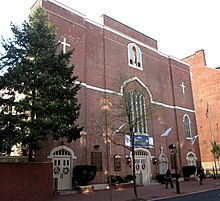Michael Francis Egan
Michael Francis Egan OFM (September 29, 1761 – July 22, 1814) was an Irish American Catholic prelate who served as Bishop of Philadelphia from 1808 until his death.
[7] Later that year, he was also appointed custos of the Pontifical College at Sant’Isidoro a Capo le Case, the home of Irish Franciscans in Rome.
[6] Accepting an invitation from the Catholics near Lancaster, Pennsylvania, Egan arrived in the United States in January 1802 to serve as assistant pastor to Louis de Barth at Conewago Chapel in Adams County.
[15] The following year was consumed by another outbreak of yellow fever, and Egan joined John Rossiter, the pastor of another of Philadelphia's four Catholic churches, St. Joseph's, in ministering to the sick.
[16] In 1806, they worked with the parishioners of a third church, Holy Trinity, to found an orphanage, as the problem of orphaned children had been made worse by the yellow fever deaths.
[17] The Catholic population in the United States was growing, and Bishop John Carroll had for some time wished for his vast diocese to be divided into more manageable territories.
[18] On April 8, 1808, Pope Pius VII granted Carroll's request, erecting four new sees in the United States and elevating Baltimore to an archdiocese.
[6] When it arrived, Egan traveled to St. Peter's Pro-Cathedral, in Baltimore, where he was ordained bishop by Carroll, assisted by Benedict Joseph Flaget and Jean-Louis de Cheverus, who had been appointed to bishoprics but had not yet been consecrated.
[25] Egan and the trustees became further embroiled in a dispute about clerical salaries, a situation possibly made worse by the decline in shipping income in the port city caused by the outbreak of the War of 1812.
[31] He continued to raise funds for the Catholic orphanage and opened a new parish, Sacred Heart, in Trenton, New Jersey, in 1813, which brought the total number of churches in the diocese to 16.
[33] While 19th-century chroniclers suggest that it "may be said in all truth that Bishop Egan died of a broken heart,"[33] modern biographers believe that his health troubles more closely resembled tuberculosis.
[34] In 1869, after the construction of the Cathedral Basilica of Saints Peter and Paul on Logan Square, his remains were removed there and reburied in a crypt along with those of his successor in the see of Philadelphia, Henry Conwell.
